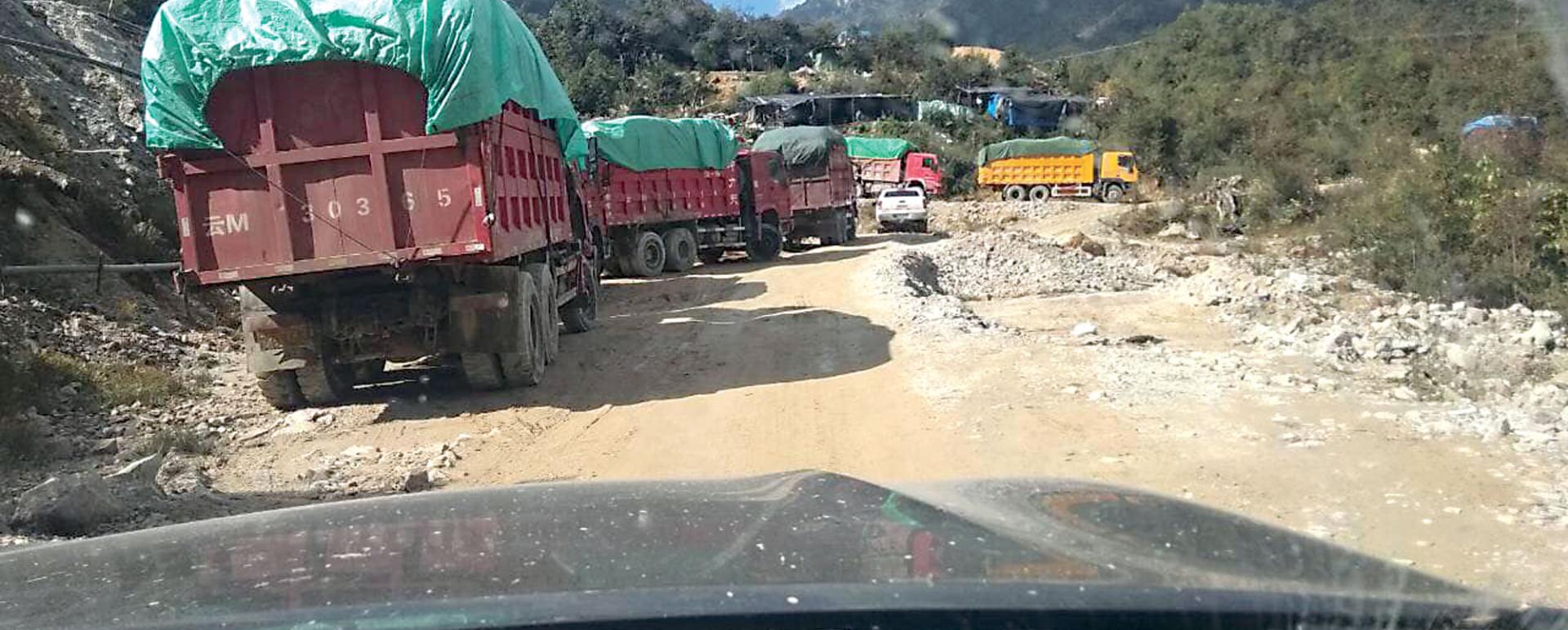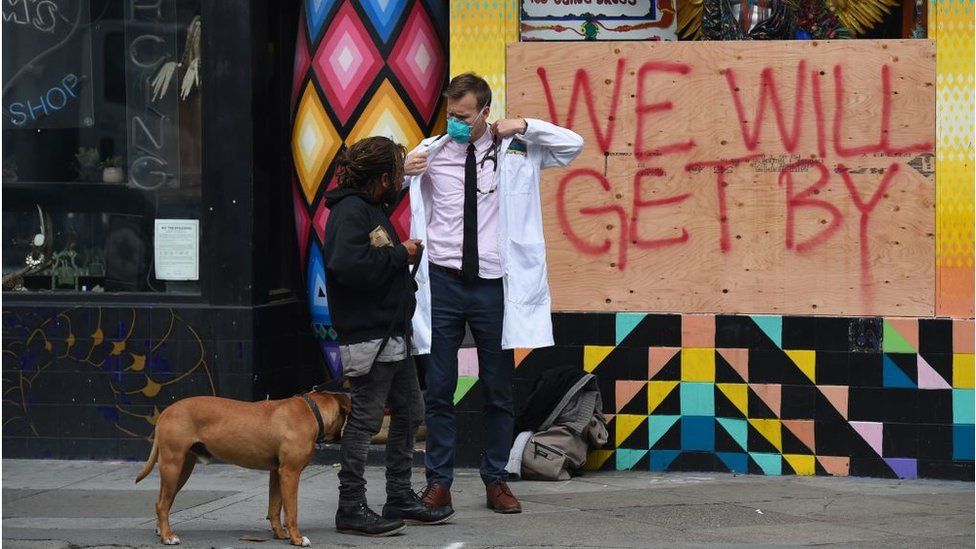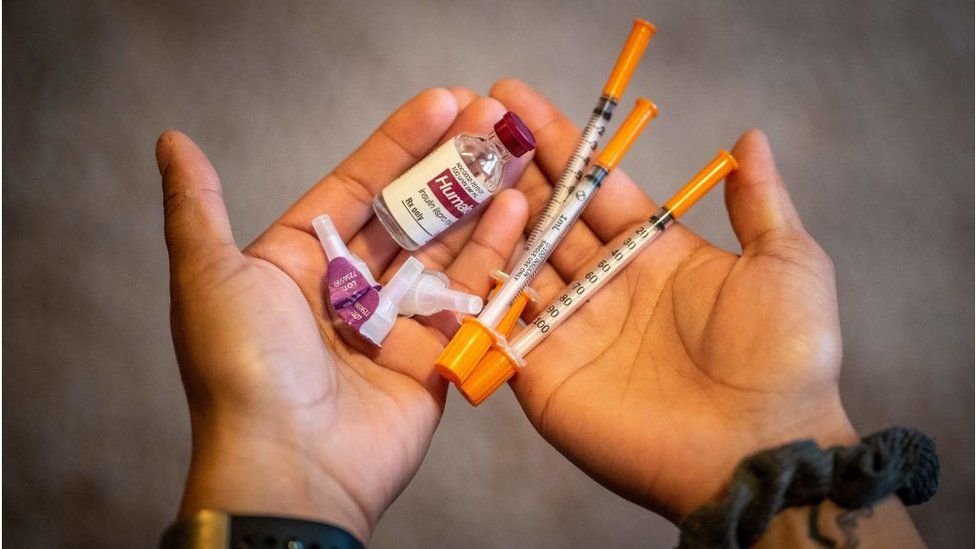Illegal Rare Earth Mines on China Border Multiply Since Myanmar’s Coup
A convoy of trucks loaded with Ammonium Sulphate.
Photo-Mines Department in Kachin State
Rare earth mining in Pangwa Township, Kachin State, in 2019. / Myitkyina Journal
By THE IRRAWADDY 26 April 2021
Illegal rare earth mining has surged in northern Kachin State on the Chinese border following Myanmar’s Feb. 1 coup in areas controlled by a junta-sponsored militia.
Environmental groups say mining has increased at least five times in Pangwa and Chipwi townships amid Myanmar’s political turmoil, with a rapid influx of Chinese workers.
“Before the coup, we only saw one or two trucks per day. Now there is no proper inspection we are seeing 10 to 15,” an activist in Chipwi told The Irrawaddy.
He said the trucks are loaded with ammonium sulphate fertilizer bags filled at illegal mines.
“The Chinese authorities have tightened border security for imports from Myanmar due to COVID-19. But materials for the mining move across the border easily,” he added.
Myanmar is China’s largest rare earth source, accounting for over half of its supplies. In 2016, Chinese mining companies entered Pangwa looking for rare earth as Beijing cracked down on illegal mining within China.
According to Chinese customs data, China is heavily dependent on medium and heavy rare earth from Myanmar. Myanmar became China’s largest importer in 2018. In 2020, rare earth imports from Myanmar rose by 23 percent year on year to around 35,500 tons, accounting for 74 percent of imports, according to the Global Times government mouthpiece.
Ja Hkaw Lu of the Transparency and Accountability Network Kachin (TANK) told The Irrawaddy: “Under the civilian government, if we complained about illegal rare earth mining, officials immediately visited and investigated. [Illegal miners] stayed away but now it is totally out of control.”
She added: “Currently, vehicles carrying heavy rare earth leave day and night. The situation is getting worse. There has been an influx of Chinese miners.”
Heavy rare earth from Kachin State is exported to China for refining and processing and then sold around the globe, according to environmental protection groups.
According to TANK, around 10 rare earth mines have opened near the border in Zam Nau, which is controlled by the military-affiliated New Democratic Army Kachin (NDAK).
Kachin environmental groups estimate that there are over 100 rare earth mines in Pangwa and Chipwe townships controlled by the militia and Chinese investors.
The Chinese media has reported that some Chinese companies are facing rising logistical costs exporting rare earth from Myanmar since the military takeover.
But Chinese buyers have not seen any significant decline in imports since the coup, the Chinese media reported.
According to the Kachin State Mining Department, only the union administration can give permission for rare earth mining in Pangwa and Chipwi. The department said it found several illegal mines and Chinese workers in 2019 and 2020 after a series of inspections. The department has said the involvement of armed groups makes regulating the industry challenging.
Brang Awng of the Kachin State Working Conservation Group told The Irrawaddy that the mines cause environmental destruction, polluting waterways and groundwater.
“Illegal digging is on the rampage since there are no checks by government officials since the military coup. More digging will further damage the environment,” he said.
The group said more than 20 villages were suffering from polluted soil and water from rare earth mining. In 2020 and 2019, the Chipwe river twice turned red due to mining waste, according to environmental groups.
By THE IRRAWADDY 26 April 2021
Illegal rare earth mining has surged in northern Kachin State on the Chinese border following Myanmar’s Feb. 1 coup in areas controlled by a junta-sponsored militia.
Environmental groups say mining has increased at least five times in Pangwa and Chipwi townships amid Myanmar’s political turmoil, with a rapid influx of Chinese workers.
“Before the coup, we only saw one or two trucks per day. Now there is no proper inspection we are seeing 10 to 15,” an activist in Chipwi told The Irrawaddy.
He said the trucks are loaded with ammonium sulphate fertilizer bags filled at illegal mines.
“The Chinese authorities have tightened border security for imports from Myanmar due to COVID-19. But materials for the mining move across the border easily,” he added.
Myanmar is China’s largest rare earth source, accounting for over half of its supplies. In 2016, Chinese mining companies entered Pangwa looking for rare earth as Beijing cracked down on illegal mining within China.
According to Chinese customs data, China is heavily dependent on medium and heavy rare earth from Myanmar. Myanmar became China’s largest importer in 2018. In 2020, rare earth imports from Myanmar rose by 23 percent year on year to around 35,500 tons, accounting for 74 percent of imports, according to the Global Times government mouthpiece.
Ja Hkaw Lu of the Transparency and Accountability Network Kachin (TANK) told The Irrawaddy: “Under the civilian government, if we complained about illegal rare earth mining, officials immediately visited and investigated. [Illegal miners] stayed away but now it is totally out of control.”
She added: “Currently, vehicles carrying heavy rare earth leave day and night. The situation is getting worse. There has been an influx of Chinese miners.”
Heavy rare earth from Kachin State is exported to China for refining and processing and then sold around the globe, according to environmental protection groups.
According to TANK, around 10 rare earth mines have opened near the border in Zam Nau, which is controlled by the military-affiliated New Democratic Army Kachin (NDAK).
Kachin environmental groups estimate that there are over 100 rare earth mines in Pangwa and Chipwe townships controlled by the militia and Chinese investors.
The Chinese media has reported that some Chinese companies are facing rising logistical costs exporting rare earth from Myanmar since the military takeover.
But Chinese buyers have not seen any significant decline in imports since the coup, the Chinese media reported.
According to the Kachin State Mining Department, only the union administration can give permission for rare earth mining in Pangwa and Chipwi. The department said it found several illegal mines and Chinese workers in 2019 and 2020 after a series of inspections. The department has said the involvement of armed groups makes regulating the industry challenging.
Brang Awng of the Kachin State Working Conservation Group told The Irrawaddy that the mines cause environmental destruction, polluting waterways and groundwater.
“Illegal digging is on the rampage since there are no checks by government officials since the military coup. More digging will further damage the environment,” he said.
The group said more than 20 villages were suffering from polluted soil and water from rare earth mining. In 2020 and 2019, the Chipwe river twice turned red due to mining waste, according to environmental groups.


















